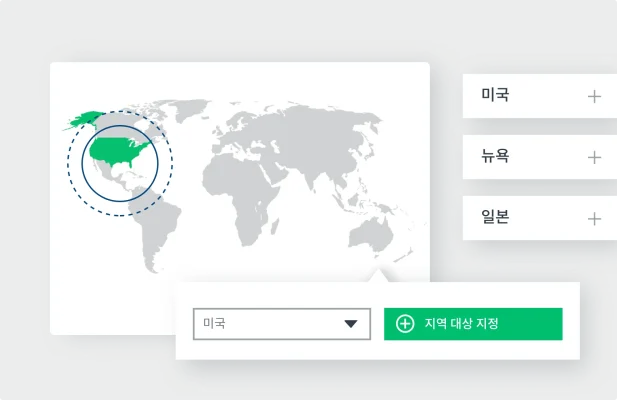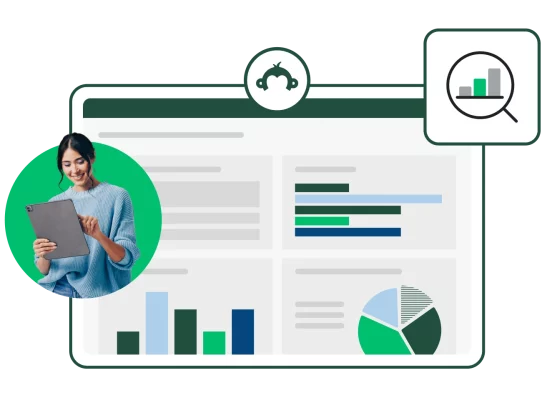시장 세분화의 5가지 유형 및 사용 방법(예시 포함)

- 시장 세분화는 광범위한 소비자 시장을 공유된 특성을 기반으로 더 작고 뚜렷한 그룹으로 분류하는 관행입니다.
- 시장 세분화는 기업들이 특정 그룹을 더욱 효과적으로 타겟팅하여 고객 만족도를 높이고 비즈니스 성과를 개선할 수 있도록 해주기 때문에 매우 중요합니다.
- 시장 세분화의 5가지 유형은 인구 통계적, 심리적, 행동적, 지리적, 기업적 세분화입니다.
각 고객은 고유하지만 비슷한 점을 띠고 있는 생동감 넘치는 모자이크와 같습니다. 시장 세분화는 이러한 패턴을 인식하고, 공유된 특성을 기반으로 고객을 그룹화하며, 고객의 집합적인 필요와 욕구에 부합하는 전략을 만드는 기술입니다.
기업은 시장 세분화로 그룹을 만든 후 이러한 세그먼트를 대상으로 더욱 효과적인 광고를 수행할 수 있습니다. 각 세그먼트에는 세그먼트를 구분하는 특정 선호도가 있을 수 있습니다. 기업은 각 그룹이 보고 싶어 하는 것에 집중하면서 참여도를 높이고, 상호 작용을 강화하며, 판매를 촉진할 수 있습니다.
시장 세분화란 무엇인가요?
시장 세분화는 광범위한 인구를 이들이 공유하는 특정 요소에 따라 하위 그룹으로 나누는 과정입니다. 이러한 그룹은 공통된 인구 통계(나이, 젠더 등), 지리적 위치, 태도, 행동 또는 비슷한 특성들의 조합을 가질 수 있습니다.
공통 요소를 기반으로 더 작은 그룹을 만들면 대상 그룹을 더 효과적으로 타겟팅할 수 있습니다.
목표 시장의 특성을 알고 계신가요?
SurveyMonkey 소비자 세분화로 빠르게 알아보세요.
시장 세분화를 사용하는 이유
기업은 시장 세분화를 통해 각 시장 세그먼트의 상세 프로필을 개발할 수 있습니다. 이러한 세그먼트가 명확하게 정의되고 나면 마케터가 제품 및 서비스를 구매할 가능성이 가장 높은 세그먼트를 위한 전략을 세울 수 있습니다.
그 목표를 달성하기 위해 마케터는 그러한 구매자들이 누구이며 제품을 구매하는 이유가 무엇인지를 명확히 밝히는 3단계 과정을 거칩니다.
- 세그먼트: 마케터는 공유된 특성을 기반으로 시장을 여러 카테고리로 나눕니다.
- 타겟팅: 제품을 구매할 가능성이 가장 높은 시장이나 대상을 선택합니다.
- 포지셔닝: 마케터들은 어떤 제품, 가격, 프로모션 및 장소의 조합이 고객들의 제품 구매를 유도할 수 있는지 조사합니다.
마케터가 타겟팅하는 대상 그룹을 구분했다면, 이제 자신의 제품이 어떻게 다른지 정의해야 합니다. 경쟁 제품보다 성능이 더 우수합니까, 속도가 더 빠릅니까, 가격이 더 저렴합니까, 아니면 더 진보되어 있습니까? 마케터는 이러한 질문에 답하기 위해서 대상 그룹의 문제점과 그러한 문제점을 창의적으로 해결할 수 있는 방법을 이해해야 합니다.
기업들은 제품 차별화를 통해 경쟁 우위를 확보하고, 자사 제품과 서비스가 구매자들의 문제에 대한 솔루션으로 두각을 나타내도록 돕습니다.
목표 시장을 식별하고, 문제를 파악하고, 그러한 문제를 해결하는 제품을 만들면 마케터는 경쟁사보다 성공할 가능성이 더 높아집니다.
시장 세분화의 예
시장 세분화는 성공적인 제품 마케팅을 위한 첫 번째 단계입니다. 소비자를 대상으로 마케팅을 하든, 기업을 대상으로 마케팅을 하든 시장 세그먼트는 기업이 고객의 문제점을 더 잘 이해하고 해결하는 데 도움이 됩니다.
모든 회사가 동일한 방식으로 고객을 세분화하는 것은 아닙니다. 회사가 사용할 수 있는 여러 가지 접근 방식이 있습니다.
다음은 시장 세분화의 세 가지 일반적인 예입니다.
세분화하지 않음
기업이 차별화되지 않은 전략을 사용하여 모든 사람에게 제품을 판매하는 매스 마케팅을 사용합니다. 예를 들어 소금과 같은 상품이나 많은 대체품이 있는 일반적 품목의 경우에는 시장 세분화에 많은 노력을 들일 필요가 없습니다.
제한된 세그먼트
회사에서 하나 이상의 정밀하게 정의된 목표 시장을 사용하여 전문화된 제품을 위한 고도로 집중된 틈새 시장을 공략할 수 있습니다. 고급 하이패션 의류, 수공예품, 커스텀 기계 부품이 그 예입니다.
수천 개의 세그먼트
초세분화로 알려져 있으며, 마케터는 각 고객에 대한 일대일 마케팅 접근 방식을 맞춤화하여 고객과의 장기적인 관계를 구축할 수 있습니다. 예를 들어 미용실과 같은 개인화된 서비스나 Amazon과 같은 온라인 리테일러는 구매 기록을 바탕으로 개인 맞춤형 추천 제품을 제공합니다.
시장 세분화의 5가지 유형
몇 개의 세그먼트만 구성하든 수천 개의 세그먼트를 구성하든, 기업은 5가지 시장 세분화 유형을 이해해야 합니다.
인구 통계적, 심리적, 행동적, 지리적, 기업적 세분화와 각 유형에 포함된 내용 및 각 유형을 사용하는 방법을 알아보겠습니다.
1. 인구 통계적 세분화
인구 통계적 세분화는 공통된 특성을 가진 사람들이 구매 습관에 영향을 미치는 비슷한 라이프스타일 패턴, 취향, 관심을 가지고 있다고 가정합니다. 인구 통계는 제품 구매 가능성이 가장 높은 목표 시장을 개발하기 위해 종종 다른 세분화 접근 방식과 함께 사용됩니다.
인구 통계는 연령, 젠더, 직업, 소득, 교육 정도 등의 요소를 포함합니다.
인구 통계적 세분화를 사용하는 방법
인구 통계 세분화의 장점은 데이터 수집이 쉽다는 것입니다. 통계청 등 정부 기관은 마케팅 전략 및 비즈니스 목표를 위한 가계, 소득, 교육 및 보건 데이터를 제공합니다.
마케터는 시장 세분화를 위해 인구 통계를 사용한 후 고객 세분화에 이 동일한 정보를 사용할 수 있습니다. 인구 통계와 행동을 사용하여 다음 사항을 확인할 수 있습니다.
- 해당 제품의 시장 기회가 얼마나 큰지
- 해당 브랜드가 경쟁사와 어떻게 비교되는지
- 어떤 인구 통계 집단에서 해당 제품이나 서비스를 구매할 가능성이 가장 높은지
- 어떤 캠페인이 목표 시장에 가장 잘 반향을 불러일으킬지
행동 특성 및 기타 변수와 결합하면, 인구 통계적 세분화는 마케터가 목표 시장 내의 어떤 고객이 제품을 구매할 가능성이 높은지에 대한 인사이트를 얻고, 그들에게 적합한 마케팅 메시지를 효과적으로 전달할 수 있도록 돕습니다.
2. 심리적 세분화
심리적 세분화는 성격, 라이프스타일, 사회적 지위, 활동, 관심사, 의견 및 태도를 기준으로 사람들을 그룹으로 나눕니다. 심리적 특성은 사람들이 특정 선택을 하는 동기를 식별하므로 인구 통계를 훌륭하게 보완합니다.
최근에 목표 시장의 인구 통계를 다시 확인해 보셨나요?
변화는 빠르게 일어납니다. SurveyMonkey 소비자 세분화로 다시 포커스를 유지하세요.
심리적 세분화를 사용하는 방법
심리적 세분화는 고객의 문제, 행동 및 태도를 이해하는 강력한 방법입니다.
기업은 시장 세분화에 심리적 특성 데이터를 활용하여 다음과 같은 사항을 이해합니다.
- 소비자들이 해당 제품과 서비스를 어떻게 인식하는지
- 소비자들이 실제로 원하는 것이 무엇인지와 그 이유
- 현재 제품 또는 서비스에서 부족한 점이나 문제점
- 향후 참여를 위한 기회
- 대상 그룹과 더 효과적으로 소통하는 방법
3. 행동적 세분화
행동적 시장 세분화는 이상적인 고객의 구매 과정에서 구체적인 단계를 설명합니다. 이 형태의 세분화는 이상적인 고객이 원하는 것, 원하는 이유, 추구하는 이점, 필요를 충족하는 방법을 포함합니다.
행동적 세분화를 사용하는 방법
기업은 행동적 세분화를 사용하여 B2C 및 B2B 시장 세그먼트를 조사합니다. 기업이 구매자들의 구매 이유를 이해하면 대상 그룹에 맞게 마케팅 메시지를 더 효과적으로 개발할 수 있습니다. 행동에는 다음이 포함될 수 있습니다.
- 구매 이유: 구매자가 가장 좋은 가격, 훌륭한 평점, 안전 고려 사항 또는 다른 기준을 찾고 있나요?
- 기념일 또는 이벤트: 소비자가 명절이나 기념일을 위해 구매하고 있나요? B2B 구매자가 올해 안에 예산을 모두 사용하려고 하고 있나요?
- 제품 이점: 구매자가 최신 기술이나 가장 안전한 제품을 찾고 있나요? 아니면 최신 제품을 가장 먼저 구매하기를 원하나요?
- 구매자의 여정 단계: 구매자가 향후 구매를 위한 정보를 원하나요? 아니면 브랜드를 처음으로 사용해 보려고 하나요?
- 참여 수준: 구매자가 최신 제품을 찾는 열혈 팬인가요?
마케터가 소비자나 기업이 자사 제품을 구매하는 이유를 알면 그러한 행동을 반영하는 세분화 전략을 세울 수 있습니다.
4. 지리적 세분화
마케터는 지리적 세분화를 사용하여 구매자들이 사는 곳, 근무하는 곳, 여행하는 곳을 기준으로 그룹화할 수 있습니다.
위치는 마케터가 마케팅 메시지를 개발하기 위해 사용할 수 있는 구매 습관에 상당히 큰 영향을 미칩니다. 마케터는 국가, 지역, 시, 도, 기후대, 우편번호 등 다양한 지리적 세분화 변수를 사용합니다.
문화와 인구 밀집도(도시 또는 시골) 역시 시장 조사에 포함할 중요한 변수입니다. 이러한 위치 변수는 해당 지역의 사람들이 어떤 문제를 가지고 있으며 마케터가 그러한 문제를 어떻게 해결할 수 있는지에 영향을 미치게 됩니다.

지리적 세분화를 사용하는 방법
살고 있는 곳은 음식 선택부터 운전하는 자동차에 이르기까지 모든 것에 영향을 미칠 수 있습니다. 기업들은 지리적 세분화를 사용하여 고객에게 판매하기에 가장 좋은 제품을 결정할 수 있습니다.
지리적 세분화의 한 예는 기후대에 따라 식물을 마케팅하는 것입니다. 제라늄은 날씨가 덥고 햇빛이 많은 지역에 가장 좋고, 블루 스프루스는 혹독한 겨울이 있는 지역에 적합할 것입니다. 어떤 지역의 지리적 특성을 자세히 알면 마케터가 어떤 식물, 흙, 원예용품이 각 기후에서 가장 잘 판매될지 파악하는 데 도움이 됩니다.
의류 회사는 추운 환경에 사는 사람들에게 코트를 추천할 수 있습니다. 고객의 위치에 따라 광고하는 제품을 조정하면 고객이 구매를 고려하는 정도가 완전히 달라질 수 있습니다.
관련 문서: 세분화 설문조사를 위한 종합 가이드
5. 기업적 세분화
매해 수백만 명의 사람들이 이사합니다. 목표 시장의 지리적 프로필이 변경되었나요? SurveyMonkey 소비자 세분화로 몇 시간 내에 알아보세요.
기업적 세분화를 사용하는 방법
기업 특성 정보는 목표 시장 내에서 기업의 강점과 성공 가능성을 이해하려는 마케터를 위한 정보를 제공합니다. 재무 성과와 성장 트렌드에 초점을 맞춰 해당 시장 세그먼트가 성장 중인지, 또는 쇠퇴기를 맞고 있는지 알아봅니다.
기업 특성 데이터의 예는 다음과 같습니다.
- 산업 분류: 한국표준산업분류.
- 소유 및 법적 상태: 개인 사업체, 유한책임회사(LLC), 유한책임조합, 비상장 법인, 주식회사를 포함한 소유권 상태.
- 사업 운영 연수: 사업 운영 연수는 재무 건전성과 업계 경험의 지표가 될 수 있습니다.
- 직원 수: 직원 수로 회사 규모를 알 수 있습니다.
- 위치: 위치는 사무실, 제조 공장 또는 매장을 포함할 수 있습니다.
- 고객 및 제품: 회사가 만들거나 판매하는 제품 및 타겟팅하는 대상 그룹입니다.
- 시장 규모: 시장의 규모와 회사의 경쟁사입니다.
시장 세분화의 이점

시장 세분화는 성공적인 제품 콘셉트, 출시, 마케팅 메시지, 광고 및 기타 중대한 마케팅 활동을 위한 기초입니다.
기업은 이상적인 고객의 문제를 이해하여 가치 있는 제품 및 서비스로 그러한 문제를 해결하는 데 중요한 자원을 투입합니다. 시장 세분화에 시간과 노력을 투입한 후 기업이 얻는 이점은 무엇일까요?
더 효과적인 광고 캠페인
기업은 대상 그룹이 누구이며 이들이 원하는 것이 무엇인지 정확히 알 때 마케팅과 광고에 큰 비용을 지출합니다. 마케터는 대상 그룹에 대한 방대한 정보를 수집하여 마케팅 메시지가 반드시 해당 제품의 적합한 고객에게 적시에 호소력 있게 전달되도록 합니다.
설문조사는 마케팅 메시지를 테스트하여 메시지가 대상 그룹에 반향을 불러일으키는지 확인하는 훌륭한 방법입니다. 먼저 설문조사 응답자가 어떻게 반응할 거라고 생각하는지에 대한 가설을 만듭니다. 설문조사 결과는 더 효과적인 메시지와 더 성공적인 캠페인을 구축할 수 있도록 돕습니다.
대상 그룹에 맞는 제품 개발
기업은 신제품에 대한 훌륭한 아이디어가 있지만 그러한 아이디어가 대상 그룹의 문제를 해결하는지 알아내야 합니다. 시장 세분화 데이터가 없다면 기업이 좋을 것으로 생각되지만 팔리지 않을 제품에 시간과 노력을 낭비하게 될 것입니다.
설문조사가 목표 시장을 이해하는 데 도움을 줍니다. 기업은 몇 시간 내에 다음과 같은 사항에 대해 알아볼 수 있습니다.
- 목표 시장의 문제를 해결하고 있는지.
- 여러 아이디어들 중 성공률이 가장 높은 것은 어느 것인지.
- 제품 콘셉트에 딱 맞는 기능, 포장 및 로고가 있는지.
- 구매자가 제품을 구매할지 여부와 지불할 가격.
잘 정의된 목표 시장으로부터 올바른 답을 얻으면 기업이 대상 그룹이 구매할 성공적인 제품에 집중하는 데 도움이 됩니다.
SurveyMonkey의 콘셉트 테스트 솔루션을 통해 해당 새 제품 아이디어가 성공적일지 알 수 있습니다. 업계 벤치마크가 포함된 제품 성과 기록표를 받으세요.
새로운 트렌드와 기회 식별
트렌드는 빠른 속도로 변합니다. 소셜 미디어는 새로운 고객 행동에 대한 인사이트를 제공할 수 있지만 마케터는 행동을 측정하지 않는 한 실현 가능한 기회인지 알 수 없습니다.
목표 시장의 행동을 이해하는 것은 시장 세분화의 핵심입니다. 새로운 트렌드가 만들어지기 시작하면 마케터는 어떤 트렌드가 새로운 기회이고, 어떤 트렌드가 곧 사라질지 알아내야 합니다.
마케터는 새로운 고객의 문제를 파악하고, 새로운 마케팅 메시지를 정의하고, 새로운 제품 콘셉트를 테스트하는 일을 맡습니다. 마케터는 새로운 기회를 파악하기 위해 대상 그룹을 자주 테스트하여 새로운 인사이트를 얻고 고객이 기존 제품을 여전히 즐겨 사용하는지 확인해야 합니다.
비즈니스 운영 팀에 의견 제공
시장 세분화에는 다른 부서들이 회사의 성공을 돕는 데 사용할 수 있는 고객 데이터를 포함한 강력한 데이터 세트가 포함되어 있습니다. B2B 회사에서는 마케팅 부서와 영업 부서가 밀접하게 연결되어 있는 경우가 많으며, 영업 부서는 더 큰 수익을 창출하는 검증된 리드를 생성하기 위해 마케팅에 의존합니다.
제품 가격 책정을 담당하는 부서 역시 정확한 제품 가격 책정을 위해 시장 및 경쟁사 데이터를 필요로 하며, 이를 통해 경쟁력을 유지할 수 있습니다. 어떤 제조 부문도 갑자기 100,000개의 제품이 필요하다고 해서 증가된 수요를 맞추기 위해 초과 근무를 하는 것을 원하지 않습니다. 구매자 트렌드 수요를 공유함으로써 생산에 차질이 없도록 할 수 있습니다.
시장 세분화 데이터는 마케팅 부서만을 위한 것이 아니며, 회사 전체가 고객에게 서비스를 제공할 수 있도록 공유해야 합니다.
브랜드 신뢰 형성
기업은 대상 그룹에게 단순히 제품을 판매하는 것만을 원하지 않습니다. 고객과의 관계를 확립하여 고객이 계속해서 제품을 구매하도록 하고 싶어 합니다. 고객이 회사의 제품을 알고, 좋아하고, 지속적으로 구매한다면 브랜드 신뢰가 형성된 것입니다.
시장 세분화는 어떤 대상 그룹이 한 번만 구매하지 않고 반복 구매할 가능성이 가장 높은지 식별합니다. 고객이 인정하는 브랜드 아이덴티티를 만들면 회사는 브랜드 인지도를 높이고 목표 시장과 신뢰할 수 있는 관계를 쌓기 시작합니다. 기업은 마케팅 메시징, 신제품, 가치 있는 콘텐츠 및 최신 정보를 만들고, 소비자와 B2B 고객사가 계속 반복 구매하게 만드는 고객 경험을 제공하면서 그러한 신뢰에 계속 집중합니다.
목표 시장 세분화는 마케터가 이상적인 고객의 문제와 행동을 이해하여 양쪽 모두에게 이로운 장기적인 브랜드 신뢰를 쌓는 솔루션을 만들 수 있도록 돕습니다.
대상 그룹과 어떤 관계를 맺고 있나요?
SurveyMonkey 브랜드 트래커로 브랜드 신뢰를 쌓는 데 필요한 것이 무엇인지 알아보세요.
SurveyMonkey로 데이터 세분화
기업은 시장 세분화를 이해하여 모든 고객이 좋아할 더욱 매력적이고 맞춤화된 콘텐츠를 만들 수 있습니다. 대상 그룹을 세분화하는 것은 효과적인 마케팅 자료를 전달하고 고객의 참여도를 높이는 데 매우 중요합니다.
시장 조사 시작하기
글로벌 설문 패널
대표 표본에 설문조사를 보내 시장 조사 데이터를 수집하세요.
전문가 솔루션
분석 및 보고에 자동화된 접근 방식을 사용하여 크리에이티브 또는 제품 콘셉트를 테스트하세요.
